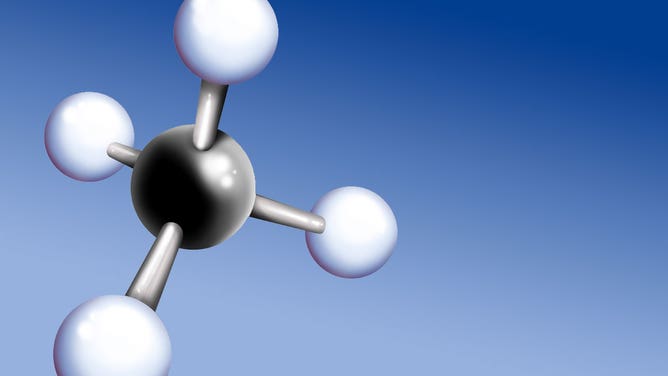Why methane has taken center stage in climate change plans
This greenhouse gas is ‘best tool’ to quickly reduce global warming, professor says

A model of a methane molecule shows the carbon atom (black) and the four hydrogen atoms (white) it contains.
(BSIP/UIG Via Getty Images)
Leaders gathered at the United Nations Climate Change Conference, better known as COP26, this week spent a lot of time talking about reducing methane emissions.
While it is just one of several greenhouse gases that scientists have said need to be reduced to stop climate change, cutting down methane emissions may be one of the fastest ways to address the issue.
"Reducing methane emissions is the best tool we have to slow global warming quickly -- over the next decade or two," said Rob Jackson, professor of earth sciences at Stanford University and chair of the Global Carbon Project.
Let’s take a closer look at methane and its important role in climate change.
What is methane?
Methane is a flammable gas that is used as a fuel around the world.
It is also a hydrocarbon, meaning it is made of both hydrogen and carbon atoms. In methane’s case, CH4, it consists of one atom of carbon and four atoms of hydrogen.
"Methane is the simplest hydrocarbon and comprises more than 90% of natural gas," Jackson said.
It does occur naturally in Earth’s atmosphere but in very small quantities.
Why is it considered a greenhouse gas?
Methane is very good at absorbing heat and holding that heat in the atmosphere. In fact, it’s so good, that it’s the second most powerful greenhouse gas behind carbon dioxide.
"A pound (or ton) of methane released into the air warms the Earth 30 to 90 times more than a pound (or ton) of carbon dioxide," Jackson said.
While methane is found naturally in the atmosphere, it’s in such small quantities that normal levels of it wouldn’t be a problem. However, the levels of methane in the air have increased by about 150% since 1750, according to the UCAR Center for Science Education.
"It’s responsible for one-third of recent warming over the last decade," Jackson said.
How much methane is emitted each year?
According to the Environmental Protection Agency, methane made up about 10% of all greenhouse gas emissions in the U.S. in 2019.
Levels of methane in the atmosphere surged in 2020 to 14.7 parts per billion, according to the National Oceanic and Atmospheric Administration. That is the largest annual increase since tracking of levels began in 1983.
Where do methane emissions come from?
According to NOAA, methane is a byproduct of fossil fuel development, decay of organic matter in the wetlands and livestock farming.
Jackson said most of the agricultural emissions come from cattle and rice paddies.
Why are world leaders putting so much emphasis on methane emissions reduction?
One of the good things about methane is that it stays in the atmosphere for a much shorter amount of time than the more abundant greenhouse gas carbon dioxide.
According to Jackson, carbon dioxide can last in the atmosphere for centuries whereas methane lasts, on average, for a few decades.
US CLIMATE PLAN INCLUDES REDUCING METHANE EMISSIONS WORLDWIDE 30% BY 2030
"Cut methane emissions a lot today and the concentration of methane in the atmosphere will start to drop almost immediately," Jackson said. "It’s the best lever we have to reduce warming a lot over the next few decades."
That speed becomes extremely important for the goal of drastic emission cuts by 2030 and holding global temperature rises to 1.5 degrees Celsius above pre-industrial levels.